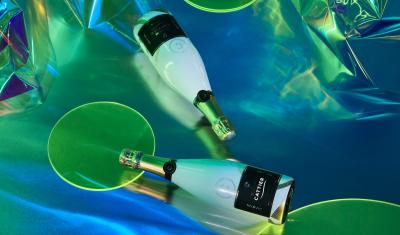Flexible OLEDs: introduction and market status - Page 5
DSCC sees fast growth ahead for automotive OLED displays
DSCC says that even though the display market is facing difficult market conditions, the automotive displays segment is expected to continue growing, and total shipments (both LCDs and OLEDs) are expected to exceed 200 million panels (an average of over 2 displays per car).
OLEDs are still a small percentage of the market (less than 0.5%, in fact), but OLEDs will gradually penetrate high-end applications for flagship models, as OLED makers adopt flexible and tandem-architecture technologies.
Cattier launches OLED-powered interactive Champagne labels
French Champagne maker Cattier launched illuminated and interactive labels, powered by OLED lighting panels produced by Inuru. The project was handled by bespoke packaging platform Packhelp. The Cattier label lights up as the champagne is being poured from the bottle into a glass, and the illumination can be also enabled on demand, by a simple touch.
Inuru says that the first batch of bottles with the new labels will ship soon on select markets. Inuru produces flexible and water-proof OLED lighting panels using a printing process.
OLEDWorks shows new flexible and rigid automotive OLED lighting solutions
Last week at CES, OLEDWorks demonstrated some of its latest automotive OLED Lighting solutions. Developed together with Corning, Valeo and STMicroelectronics, OLEDWorks’ newest demonstrator contained the highest density of individually addressable segments of any flexible OLED panel.
You can see the new flexible OLED demonstrator in the video above on the left (the device on the right uses rigid OLED panels). OLEDWorks says that individually segmented OLED lighting panels increase safety on the road by allowing for improved communication through dynamic animation sequences and symbols. Manufacturing these OLED panels on flexible glass further expands lighting design opportunities with the ability to conform with curved surfaces in the car, integrating lighting directly into the vehicle’s architecture.
Samsung set to demonstrate a foldable and slidable AMOLED display
According to a report from Korea, Samsung Display will unveil a new display at CES 2023, which is both foldable and slidable. The display is 8-inch in size when folded, opens up to a 10" display when unfolded, and then can be slided further to 12.4".
The display will be shown in a private booth, which will not be open to the public. It is likely that this display is still at an early stage of development, as there are many challenges such as durability and quality that Samsung will need to overcome. The report suggests, though, that Samsung is ready to soon commercialize such a panel.
UBI sees sales of rigid OLED panels to continue and decline, while flexible and foldable OLEDs are on the rise
UBI Research says that according to its latest information and forecasts, shipments of Samsung's rigid smartphone AMOLED displays declined to 19 million units in Q3 2022, a drop of over 50% compared to last year. Rigid smartphone OLED display sales will continue to decline at an annual rate of 12.9% and will reach only only 96 million units in 2027.
Flexible OLED sales will continue to increase at a rate of 7.4% from 2022 to 2027. In 2027, Samsung Display will ship 220 million flexible OLED displays, while BOE will ship 140 million OLEDs.
Visionox signs an agreement with the government of Hefei to build its $1.6 billion flexible OLED module fab
In May 2022, Visionox announced plans to build a 11 billion Yuan ($1.6 billion USD) flexible and foldable OLED module production line, in Hefei. Yesterday the company signed the formal agreement with the local government and kickstarted the project.
According to reports from China, the new factory will have a yearly capacity of around 26 million modules in sizes ranging from 6-inch to 12-inch, although the company says it will also produce wearable OLED display modules at this fab, so there will be smaller sizes as well.
Researchers suggest using a wearable blue OLED device to treat neonatal jaundice
Researchers from Korea's KAIST institute developed a fabric-based wearable patch that uses a blue OLED device to treat jaundice in newborns.

The researchers say that phototherapy is the most widely used treatment for neonatal jaundice, as it is a safe and effective to transform the bilirubin that is accumulated in the body and release it. When the bilirubin concentration is too high, the doctors treat newborns with blue light in an incubator. The new device can be used to treat high levels of bilirubin, without the need for an incubator.
TCL CSoT suggests a new hinged-pixel design for stretchable displays
TCL CSoT says that it has developed a new hinged-pixel design that can enable uniform stretchable displays.
![]()
The idea is to connect adjacent pixels with flexible hinges, so that when the display is stretched, the hinges make sure the pixels retain a fixed distance between them. The company says that this design can remain uniform for up to 40% expansion.
Lenovo and Motorola show new rollable device prototypes
During Lenovo's Tech World 2022 event, the company and its Motorola subsidiary showed new device prototypes, including two interesting rollable OLED devices.
In the video above, you can see a new laptop prototype that has a rollable OLED display, that opens up to increase the screen size. There's also a smartphone that opens from a 4-inch display to a 6.5-inch one using a rollable display.
Intel and Samsung Display show a rollable 17-inch AMOLED display prototype
During Intel's Innovation Day 2022, Samsung Display's CEO shows a prototype rollable AMOLED laptop display that opens up from 13-inch to 17-inch:
Over the years, Intel has been working with display makers to showcase innovative new display technologies. In early 2020 the company showed a foldable 17-inch laptop device.
Pagination
- Previous page
- Page 5
- Next page




